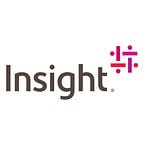Going Cloud Agnostic to Create a More Agile Edge
By Ben Kotvis, Senior Architect, Digital Innovation at Insight
The pace of intelligent edge innovation and disruption across industries has never been faster, and momentum will only increase from here. Insight’s Accelerate series explores angles of this phenomenon from a variety of experts who are seeing these innovations through, from technology development at the ground floor to enterprise-wide implementation.
With intelligent edge, some data processing happens on-site — but this doesn’t eliminate the need for a well-thought-out centralized data processing center that may be best served from the cloud.
The goal of a cloud-agnostic architecture approach for the intelligent edge is simple: to develop a solution that allows a subset of your computing workloads to run on the edge, which will be decoupled from the cloud-based solution so that a cloud platform can be changed without needing to rewrite significant portions of the code-base or deployment pipelings. The result will be a solution with architecture that allows for agility and adaptability.
Here is what you need to know …
Hosting via cloud vs. on-premises
Many business leaders may have some familiarity with the flexibility of hosting with cloud solution providers for off-the-shelf, prescriptive web-based solutions — and know that there’s often a trade-off between flexibility and maintenance. However, on-premises rather than cloud hosting provides maximum flexibility when it comes to combining services a la carte to devise a solution unique to your businesses needs, and even flexibility in controlling pricing. Intelligent edge is largely on-premises and so the same concerns applied to on-premises hosting are applicable to intelligent-edge computing.
Key hosting factors to consider
On-premises and edge hosting concerns are generally the same, and these factors are important to consider regardless of the hosting mechanisms you utilize.
Security: Is the hosting solution providing enough security for the business’s data? Hosting on-premises may entail physical control of the data (unlike hosting via cloud), but this does not negate access and security concerns. Are holistic security solutions built into the hosting solution’s infrastructure?
Scale: Is quick scalability possible? For example, is it possible to add more virtual machines to increase processing capabilities? Note that when using edge computing, there are finite resources at the edge rather than a data center, which may impact scalability.
Interoperability: Does the hosting allow for easy interaction with other systems to plug and play solutions rather than build from scratch?
Maintenance: Will you need to manage maintenance (such as operating system patches) internally or are you able to access maintenance support from a service provider?
Decoupling from a cloud solution provider
Decoupling cloud architecture in a solution — or the process of allowing each component to perform its tasks independently towards a greater output without being tied to a single cloud provider — increases the solution’s deployment flexibility and scalability. Each component remains completely autonomous, allowing solutions to integrate or operate with a wider array of devices.
The first steps for decoupling are to:
- Consider coupling during the initial design and implementation phase for easier solution implementation and decouple to emphasize customization and scalability.
- Create abstractions for software development kits (SDK) and application programming interfaces (API) where coupling would normally exist.
- Consider agnostic service providers for your intelligent edge solutions.
Primary areas of concern when implementing cloud agnostic
Containerization: Containers are very small, application-specific computing modules that provide a specific implementation to solve a particular problem. Containers allow for version management (onboarding a newer or older version of a container), simplify operating system dependencies, and allow networking between containers and communication within containers without allowing outside access. Cloud-agnostic intelligent edge expands these capabilities.
Storage: Keep in mind you must be cognizant of storage at every stage and manage your storage by removing unnecessary data and images routinely to save memory and keep the device running well.
Development: When building a container, you need to develop registry management so the data has a location to go to be processed. Cloud service providers can provide registries, or you can build this yourself.
Machine Learning Operations (MLOps): This is the process through which you compile your solutions and deploy a configuration that delivers the data from the containers to a device, and this process tells the device which images or data it should be processing. Intelligent-edge models should be able to be “retrained” and fed new patterns to fine-tune data processing capabilities. This training and retraining will not take place at the edge but rather on-premises or through the cloud, so this step is highly impacted by a cloud-agnostic design.
Ultimately, intelligent-edge solutions require cloud as well as on-premises computing. Creating an effective cloud-agnostic solution requires considering what portion of devices will run on the cloud and implementing design in a way that allows for the increased flexibility and agility that agnosticism provides. Planning for these considerations during the implementation of intelligent-edge solutions saves businesses time and resources down the road when scalability and flexibility become more important to achieving business goals.
If you’d like to hear more from Ben on cloud agnostic intelligent-edge, you can watch his webinar, Cloud Agnostic Intelligent Edge, as part of Insight’s Accelerate series.
Ben Kotvis is a senior architect of Digital Innovation at Insight. Ben has spent the last several years building IoT solutions for residential, agricultural, manufacturing and heavy machinery applications. Writing software in .NET, he works to solve business problems by introducing automation and building robust, cloud-based applications. He’s passionate about delivering value to his clients as well as building solutions where scaling and performance are part of the design from the first line of code to go-live.
